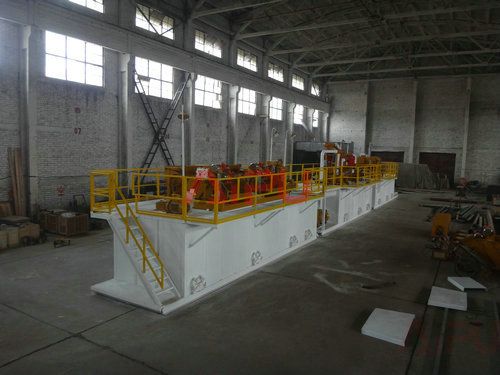While drilling wells, drilling fluid is processed at the surface to remove drilled solids and blend the necessary additives to allow drilling fluid to meet specifications. Drilling-fluid processing systems are described in this book from both a theoretical point of view and practical guidelines. It will be as useful for a student of drilling as for the person on the rig. Drill bit cuttings and pieces of formation that have sloughed into the well bore (collectively called drilled solids) are brought to the surface by the drilling fluid. The fluid flows across a shale shaker before entering the mud pits. Most shale shakers impart a vibratory motion to a wire or plastic mesh screen. This motion allows the drilling fluid to pass through the screen and removes particles larger than the openings in the screen. Usually drilled solids must be maintained at some relatively low concentration. The reason for the need for this control is explained in the next section. The shale shaker is the initial and primary drilled-solids removal device and usually works in conjunction with other solids- removal equipment located downstream.
Specific problems associated with drilled solids are:
. Filtrate damage to formations
. Drilling rate limits
. Hole problems
. Stuck pipe problems
. Lost circulation problems
. Direct drilling-fluid costs
. Increased disposal costs

The effects of drilled solids on the economics of drilling a well are subtle. Increasing drilled-solids content does not immediately result in disaster on a drilling rig. When a drill bit ceases to drill and torque increases, a driller knows immediately that it is time to pull the bit. When drilled solids increase, the detrimental effects are not immediately apparent. Decreasing drilled solids is analogous to buying insurance for an event that will not happen. Proving that something will not happen— like stuck pipe—is difficult to do. No drilling program calls for stuck pipe or fishing jobs even if they are common in an area with a particular drilling rig. The evil effects of drilled solids are real. Acknowledging that fact and preparing to properly handle them at the surface will result in much lower drilling costs.
So we need the solids control equipment to control solid content or cuttings percentage in whole drilling fluid system. Solids-control equipment, also called solids-removal equipment or drilled-solids management equipment, is designed to remove drilled solids from a circulating drilling fluid. This equipment includes gumbo removers, scalper shakers, shale shakers, dryer shakers, desanders, desilters, mud cleaners, and centrifuges. These components, in various arrangements, are used to remove specific-size particles from drilling fluid. Knowledge of operating principles of auxiliary equipment, such as agitators, mud guns, mud hoppers, gas busters, degassers, and centrifugal pumps, is necessary to properly process drilling fluid in surface systems. However, the best equipment available is insufficient if it processes only a portion of the active drilling fluid coming from the well.